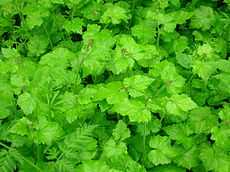Tolmiea
| Tolmiea menziesii | |
|---|---|
 | |
| Scientific classification | |
| Kingdom: | Plantae |
| (unranked): | Angiosperms |
| (unranked): | Eudicots |
| (unranked): | Core eudicots |
| Order: | Saxifragales |
| Family: | Saxifragaceae |
| Genus: | Tolmiea Torr. & Gray |
| Species: | T. menziesii |
| Binomial name | |
| Tolmiea menziesii (Pursh) Torr. & Gray | |

The plant Tolmiea menziesii /tɒlˈmiːə mɛnˈziːzi.aɪ/[1] is the only member of the monotypic genus Tolmiea. It is known by the common names youth on age, thousand mothers, and piggyback plant. It is a perennial plant commonly kept as an ornamental. It is native to the west coast of North America, e.g., in regions dominated by redwoods. It requires moisture and does not tolerate much sun or dry conditions.
The plant has unusual reproductive habits. It grows plantlets from the petiole near the base of each leaf. The plantlets drop off, fall in the soil, and take root there. It will also reproduce by rhizome and by seed propagation. It bears many small flowers in a loose raceme. Each flower consists of a tubular purple-green to brown-green calyx and four linear or subulate (awl-shaped) red-brown petals, about twice the length of the sepals. It has hairy, five to seven-lobed, toothed leaves and a capsule fruit containing spiny seeds.
The plant is also unusual in that it is sometimes diploid and sometimes tetraploid, due to autopolyploidy.
The genus was named after the Scottish-Canadian botanist William Fraser Tolmie, while the species name refers to Archibald Menzies, the Scottish naturalist for the Vancouver Expedition (1791–1795).
External links
 Media related to Tolmiea menziesii at Wikimedia Commons
Media related to Tolmiea menziesii at Wikimedia Commons- T. menziesii info page
- Jepson Manual Treatment
- USDA Plants Profile
References
- ↑ Sunset Western Garden Book, 1995:606–607
- Yarbrough, J. A. (1936). The foliar embryos of Tolmiea menziesii. American Journal of Botany 23(1) 16-20.
- Soltis, D. E. and B. A. Bohm. (1986). Flavonoid chemistry of diploid and tetraploid cytotypes of Tolmiea menziesii (Saxifragaceae). Systemic Botany 11(1) 20-25.